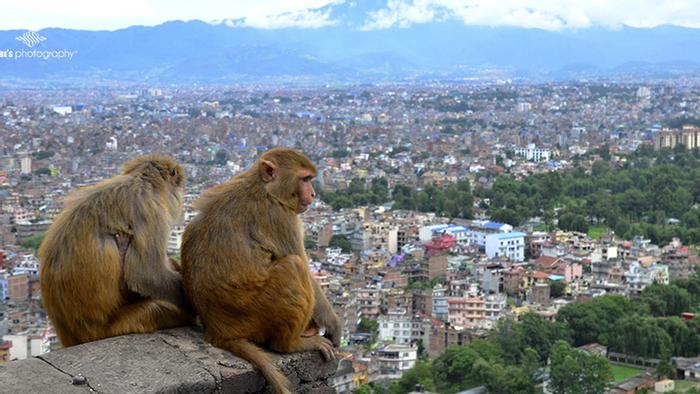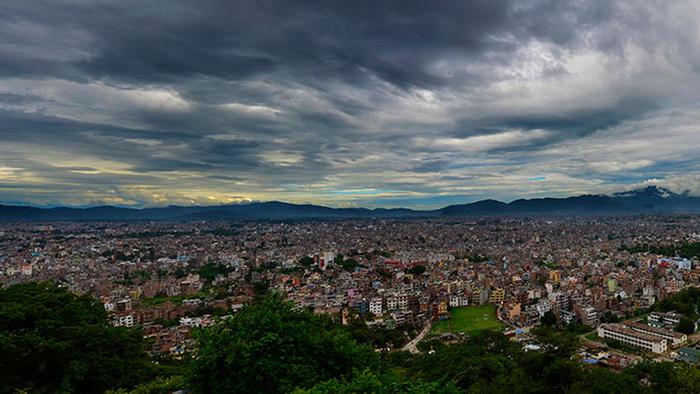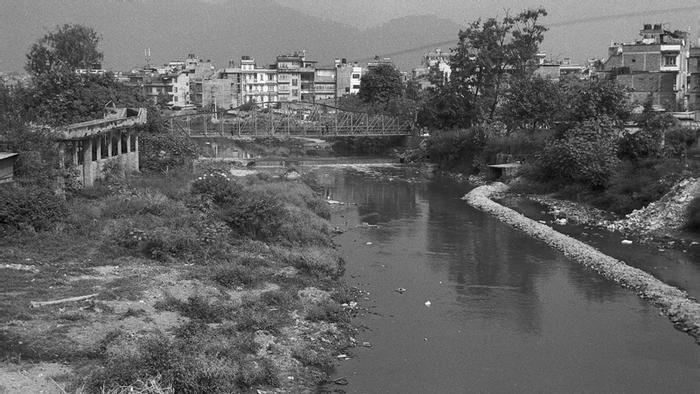Swayambhu in Himalayan lap
The chariots are multi-storied, furnished and colorful. It was dancing on people’s shoulders. Moving by the SAARC Secretariat towards the palace.
Millions of people flocked to the New Year procession. New Year's song in chorus. Drums, bells, flutes. The highway is so festive!
Same as Bengali Baishakh observed here. The remaining months also coincide with the Bengali month names. But in terms of age, this country in the Himalayas is six and a half hundred years ahead of the Bengali year. And 57 years ahead of AD.
Pohela Boishakh is the biggest yearly festival here. This is the day of the inauguration of the ruling deity Matsyendranath. He is the protector of the Kathmandu Valley. His journey started in a chariot decorated with various flags. On the first day of the week-long festival, highways are busy. Traffic jams in alleys also due to the huge procession. It took a long time to get out of the tourist area Thamel.

Navraj Chelsea's motorcycle gained speed slowly. He is a journalist by profession. Works in radio. His bike continues to descend further down the valley. Due to the topography, the place is mistaken as a valley. But the height of this land from the sea level is four and a half thousand feet.
Vishnumati river in front. The river born north of Kathmandu, in the blue valley of Shivpuri Mountain. Further south, Shivpuri Mountain merges with another river Bagmati. This Bagmati and Vishnumati are the life of the Kathmandu Valleys. The city of Kathmandu, the capital of Nepal grows on these two rivers.
The origin of the word Nepal, stated in the texts of Binod Ghimire and Rajesh Regmi's experience Nepal, ‘Ne and Bal are Tibetan wool and residence. These two added words formed Nepal. Which means wools house. '

But in the Nepal mahatta, ‘The source of the word Nepal is Nimuni. Ni and Muni. Means the province is under god's protection.' In this legend, Patan was then the capital of Thakuri king Guna Karmadeva. One day Mahalaxmi appeared in his dream. She said, "Build a city of Nimuni's abode at the confluence of Bagmati and Vishnumati."
Then the king built the city in 723 AD. The shape of that city is like the sword of Goddess Lakshmi. King named it Kantipur. He brought the capital from Patan to Kantipur.
After more than one Thousand year of that incident, in 1779, Gurkha king Prithvinarayan Shah came to Nepal. He named Kantipur as Kathmandu.
Gyanendramohan Das writes in his book `Bonger Bahire Bengali: Uttar Bharat that, ‘Gorakshanatha, a disciple of Matseyndranath, the presiding deity of Nepal, ordered King Prithvinarayan to build a temple. The king then cut down the trees and built the temple. The name of the temple is wooden because it is made of wood. From that wooden temple, later the name Kathmandu was initiated.'
This Vishnumati river is in the western part of this valley. Vishnumati did not wake up as the rains had not started yet. Dirt on both sides. The water in the middle to the knee has turned black.

After crossing an iron bridge, we reached on the footsteps of Swayambhu. Stairs to the top of the hill to the east. Chelsea's bike grabbed the road on the left side of the stairs. Twisting and turning by the mountains.
Side of the ditch is placed on the left. Pine and fur leaning on the mountain slope. On the right side of the road is a Buddhist monastery on the hillside. Hundreds of monks pray under the open sky.
Product stalls on the hillside. Scattered antiques. Shoppes of bones, stones, various metals and wood. Small statues. Mask. Various ornaments.
Hundreds of people were seen in the upstairs climbing eastern stairs. The stairs include 365 steps. Each step is a day. 365 steps mean 365 days or one year. It is believed that, climbing this hill in a day on this staircase, a one-year Swayambhu visit is done.
At the foot of the wide staircase a statue of Buddha was established in 1637. An eagle stone statue on a snake next to the stairs. Buddha on the head of that eagle. Giant thunderbolt at the top of the stairs. At its base are carved 12 animals of the Tibetan zodiac. Like the Buddha statue at the base of the stairs, this thunderbolt at the top of the stairs is also placed by King Pratapmallo.

Among the temples scattered throughout the precincts particularly eye-catching is the Manjushree shrine. In the middle of these temples and idols, Swayambhu is like a huge dome. Panchabuddha surrounds her womb. Buddha's eyes are painted in white, black and gold on the upper square structure. Four pairs on four sides. The top of the square becomes as narrow as the head of an umbrella in thirteen steps. Each step is a chapter of Nirvana. A bell symbolizes heaven on the summit.
This is the oldest temple in Nepal with its own architecture style. This traditional mound is a UNESCO World Heritage Site. Even in the fall, many were seen circling the mound. They are making noise by pulling the brass bell rope. Turning the wheel in the hope of recovery.
The eastern side of Swayambhu Square is steep. Mountain seems jumped down. Standing there, the horizon is like a wide surprise! The whole valley surrounded by mountains is like a bowl in front of the eyes. Green everywhere. Somewhere dark, somewhere light. The green form is changing in the lurking of the sun shade.
This vast valley is Kathmandu. The location of the capital city is vast in a part of this valley. Kathmandu city can be identified from so far, Bhaktapur and Lalitpur, the other two district cities of the valley.
According to the Puran, the meaning of Swayambhu is self-evident.
A legend is found in the tenth volume of Encyclopaedia compiled by Nagendranath Bose on the advent of Swayambhu in Kathmandu. In that story, this valley was a lake a long time ago. Oval shaped. Huge and deep. Surrounded by mountains. Snakes lived here. Hence the name was Nagbas Lake.

Bipassha Buddha came here from Bandumati country in the Satya Era. Settled west of Nagbas Lake. Planted the lotus roots in the lake water. Lotus bloomed from that root. God Swayambhu appeared in it.
Manjushri Bodhisatta came from China in the Treta era and visited Divyajyoti. With his sword he cut the middle of two mountain peaks named Fulchoa and Champadevi. The Huge lake's water goes out on the way. The snakes also goes out with the water. The lake became a habitable fertile valley.
Manjushree worships that Swayambhu light in the middle of the lotus. Later, the root of the lotus tree is Pashupatinath, five kilometers north-east of Kathmandu, Mahadev's temple on the banks of Baghmati. And the flower takes the form of a Stupa (pile) and sits on the bank of Vishnumati at the top of the hill. The name of the Stupa (pile) is Swayambhu Stupa as it is self-evident.
Another legend is found in David Reed's The Rough Guide to Nepal book. Manjushree cut his hair in the Swayambhu Stupa premises. As soon as they fall to the ground, the hairs become plants, the lice become monkeys.
The monkeys here therefore get devotion to the sacred knowledge. Because of them, the name of Swayambhu Stupa became Monkey Temple.
A fragmentary inscription on the temple premises states that in 464 AD, King Mandev ordered the completion of the Swayambhu temple.
According to the Experience Nepal book, the Soyambhu Stupa was severely damaged by an earthquake in the mid-fourteenth century. Pratap Malla rebuilt the present Stupa (pile) in the seventeenth century. It is widely known as the Swayambhunath Temple.
Translated by: Asasul Islam Biswas